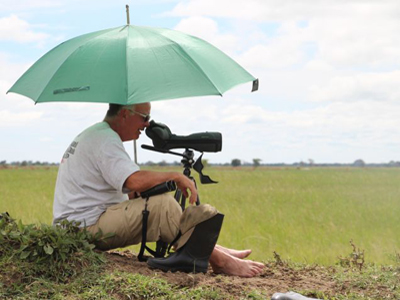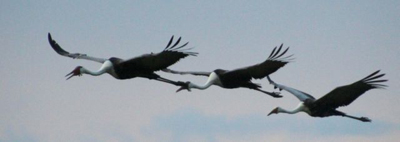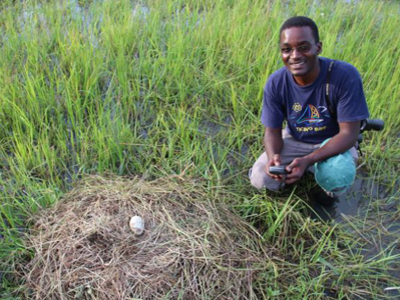| By Dr. George Archibald, ICF Co-founder & Senior Conservationist
Together with ICF’s excellent colleague, Griffin Shanungu of the Zambia Wildlife Authority, I recently had the privilege of spending four days in Lochinvar National Park (LNP) in central Zambia, a park that includes about 8 percent of the acreage of the vast Kafue Flats – a floodplain of the Kafue River and a major habitat for Wattled Cranes. Unfortunately, dams across the inflow and outflow of the floodplain have altered the fragile hydrology to reduce the extent of flooding in the upper reaches of the floodplain and to maintain abnormally high water in the lower reaches of the floodplain during the season when the plains should be dry. In addition, an invasive thorny shrub from South America is spreading across the wetlands, and a native shrub is expanding its range onto the plains as a consequence of drier conditions in more upland zones. Crane habitat is pinched between the two expanding populations of shrubs. Despite these problems, the plains still supports a plethora of wildlife, and it was our pleasure to drink in the beauty.  At 5:30 a.m. in first light, Griffin and I were stationed on an eroded termite mound from which we had a commanding view of a portion of a floodplain created by the Nampongwe River, a tributary that flows north to the Kafue River. Through our telescope we could see the white necks of an army of Wattled Cranes standing in the shallows of their nocturnal roost. We made two counts, the first by Griffin (whose eyesight is much better than mine), and second by me when there was more light. When ten birds were counted, the counter said “crane” and the recorder made a dot in his notebook. Our highest count was 780. But because of shrubs and termite mounds, some cranes could not be seen. There were a minimum of 800 cranes at the roost on the morning of February 16, 2013.   And what an assemblage of wildlife flourished within view. The waters of the Nampongwe were rife with crocodiles and hippo, while herds of about 800 Burchell’s zebra and more than 1,000 Kafue Lechwe (an aquatic antelope endemic the area) nosily splashed through the shallows when alarmed. Soon after the hundreds of cranes, spur-winged geese, and white-faced tree ducks flew to feeding areas elsewhere, an army in white – African spoonbills, marched in close formation through the shallows with splayed beaks probing the mud for food. They were accompanied by hundreds of black egrets that benefited from food brought into view by the spoonbills. But rather than walking with the spoonbills, the egrets flew short distances to keep up with the grand march. Dozens of huge pink-billed pelicans, a pair of noisy fish eagles, and a few Grey Crowned Cranes, perched in nearby trees. It was a wildlife spectacle perhaps enacted for eons before humans walked into the scene. Although humans have recently created problems for the remarkable ecosystem of the Kafue Flats, the actions of man also hold promise for restoration. Consequently, Griffin and I are looking forward to discussing next steps with ICF’s President and CEO, Dr. Rich Beilfuss, who has spent many years helping to conserve and restore wetlands in Africa. |
 
Learn more about ICF’s work in the Zambezi River basin and click on the map to view the locations of ICF’s project sites in the region.
Learn about George’s recent acceptance of The National Audubon Society’s inaugural Dan W. Lufkin Prize for Environmental Leadership.
|

